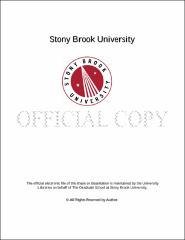| dc.identifier.uri | http://hdl.handle.net/11401/77673 | |
| dc.description.sponsorship | This work is sponsored by the Stony Brook University Graduate School in compliance with the requirements for completion of degree. | en_US |
| dc.format | Monograph | |
| dc.format.medium | Electronic Resource | en_US |
| dc.language.iso | en_US | |
| dc.publisher | The Graduate School, Stony Brook University: Stony Brook, NY. | |
| dc.type | Dissertation | |
| dcterms.abstract | Long Island Sound experiences periods of hypoxia attributed to eutrophication, but the magnitude of nitrogen contributed to surface water via submarine groundwater discharge (SGD) entering Long Island's north shore embayments is not well characterized. The coastal aquifer, where fresh groundwater mixes with saline coastal water is termed the subterranean estuary (STE). Advective flow combined with sharp salinity and dissolved oxygen gradients make the STE a zone of intense geochemical cycling. However, the fate of nitrogen during transit through Long island embayment STEs is not well understood, particularly how sediment heterogeneity influences nitrogen attenuation in discharge zones. Nitrate attenuation mechanisms, principally denitrification, were investigated in three Long Island north shore embayments; Stony Brook Harbor, Setauket Harbor and Port Jefferson Harbor. In Stony Brook Harbor an investigation of freshwater nitrate dynamics over two spring-neap tidal cycles found oscillations in depth stratified nitrate concentrations. Calculation of fresh fraction discharge revealed that water table over-height is responsible for these oscillations, which result from shore perpendicular movement of the coarse sediment freshwater discharge point. High resolution sampling of STE porewater from Stony Brook Harbor and Setauket Harbor revealed discharge of freshwater continues for tens of meters offshore, which results in two zones of nitrogen removal. When SGD discharges into surface water near low tide through coarse-grain sand or marsh sediments, denitrification rates are 15 - 50% lower than when SGD passes through into a fine grain sediment layer offshore. In Port Jefferson Harbor, results from a combined shallow porewater nitrate concentration and geochemical tracer (<super>222</super>Rn) study indicate SGD accounts for similar nitrogen flux to surface water as direct inputs from a local sewage treatment plant. Overall, embayment scale sediment heterogeneity is positively correlated with availability of dissolved organic carbon, which in turn controls the extent of microbially mediated denitrification found in each of the studied embayments. | |
| dcterms.available | 2017-09-20T16:53:18Z | |
| dcterms.contributor | Sperazza, Michael | en_US |
| dcterms.contributor | Hanson, Gilbert N | en_US |
| dcterms.contributor | Aller, Robert | en_US |
| dcterms.contributor | Bokuniewicz, Henry | en_US |
| dcterms.contributor | Kroeger, Kevin. | en_US |
| dcterms.creator | Young, Caitlin | |
| dcterms.dateAccepted | 2017-09-20T16:53:18Z | |
| dcterms.dateSubmitted | 2017-09-20T16:53:18Z | |
| dcterms.description | Department of Geosciences. | en_US |
| dcterms.extent | 181 pg. | en_US |
| dcterms.format | Monograph | |
| dcterms.format | Application/PDF | en_US |
| dcterms.identifier | http://hdl.handle.net/11401/77673 | |
| dcterms.issued | 2013-12-01 | |
| dcterms.language | en_US | |
| dcterms.provenance | Made available in DSpace on 2017-09-20T16:53:18Z (GMT). No. of bitstreams: 1
Young_grad.sunysb_0771E_11663.pdf: 6502007 bytes, checksum: 91aace5545a52abd8e8cfffe5fb91b03 (MD5)
Previous issue date: 1 | en |
| dcterms.publisher | The Graduate School, Stony Brook University: Stony Brook, NY. | |
| dcterms.subject | Chemical oceanography | |
| dcterms.subject | coastal aquifer, denitrification, nitrogen, radon, submarine groundwater discharge, zero valent iron | |
| dcterms.title | Fate of Nitrogen during Submarine Groundwater Discharge into Long Island North Shore Embayments | |
| dcterms.type | Dissertation | |

